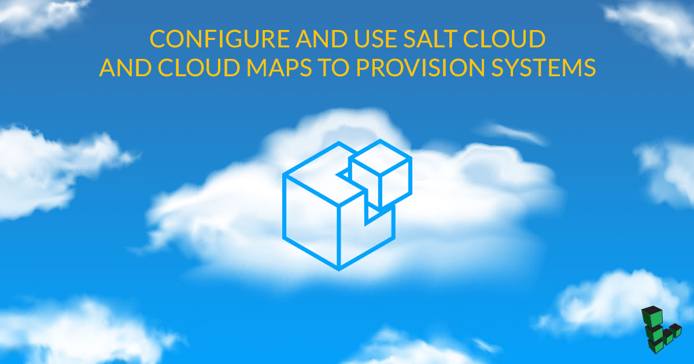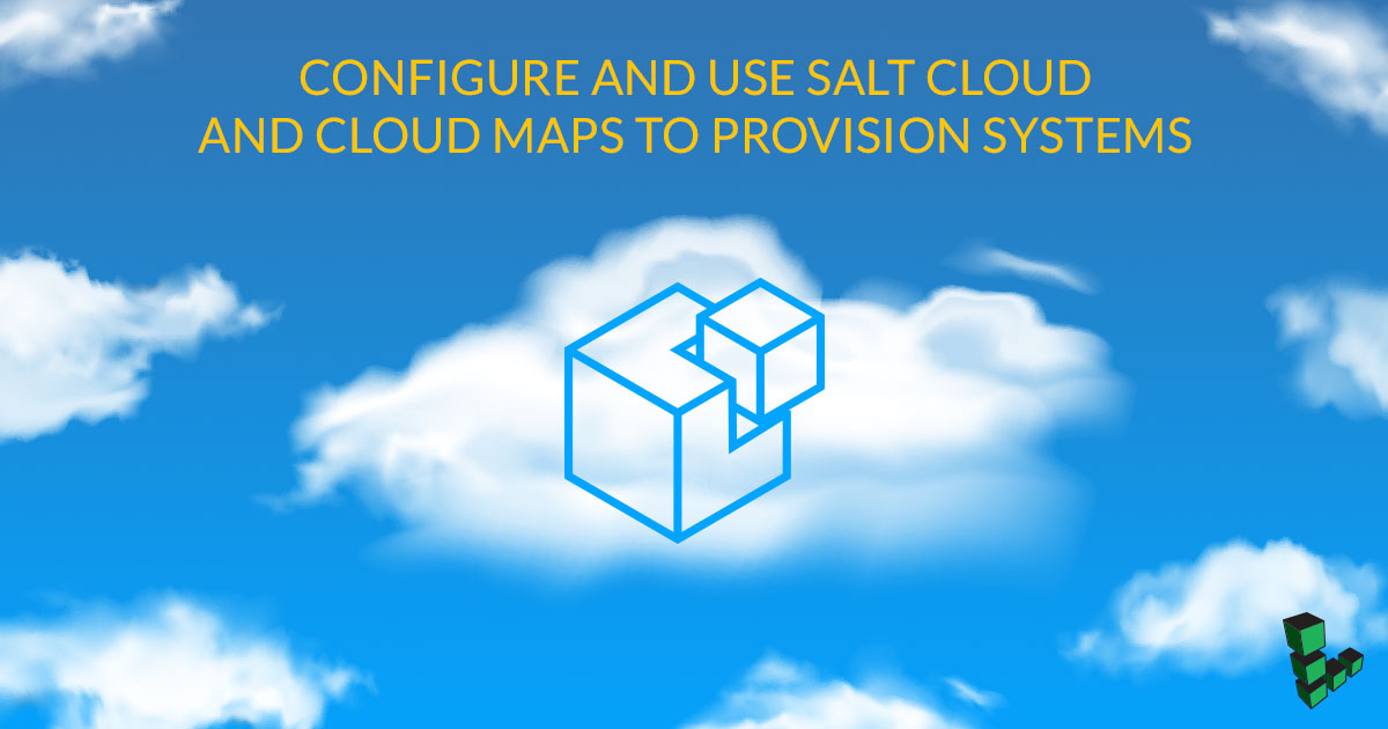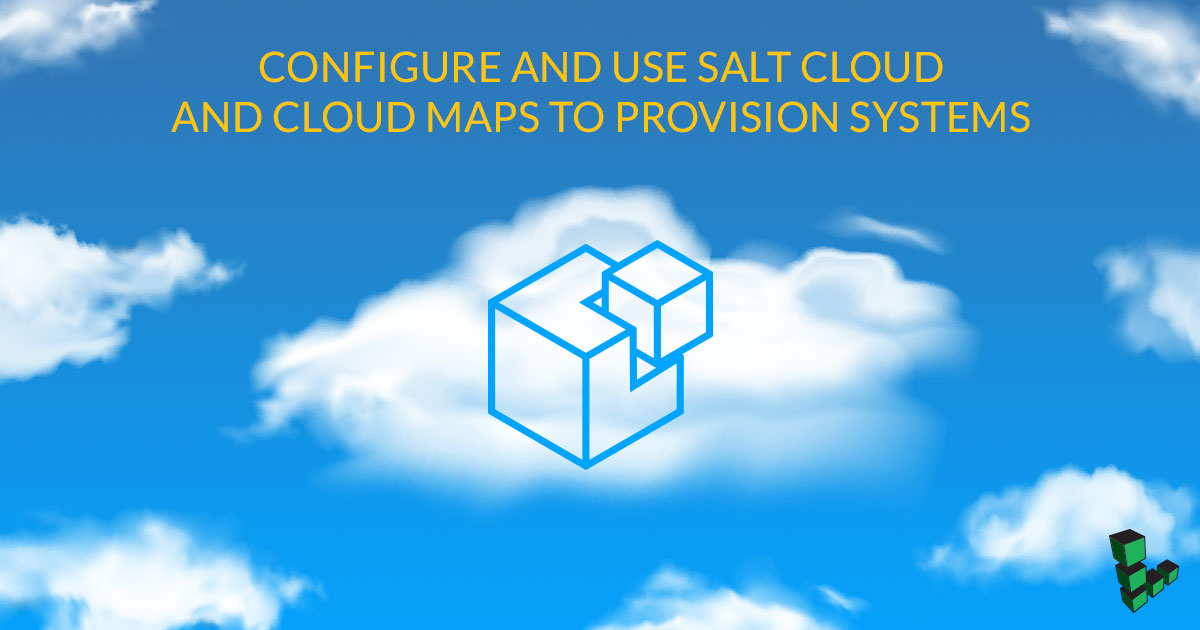Using Salt Cloud and Cloud Maps to Provision Systems
Traducciones al EspañolEstamos traduciendo nuestros guías y tutoriales al Español. Es posible que usted esté viendo una traducción generada automáticamente. Estamos trabajando con traductores profesionales para verificar las traducciones de nuestro sitio web. Este proyecto es un trabajo en curso.


What is Salt Cloud?
Salt Cloud is a configuration management tool that allows users to provision systems on cloud hosts or hypervisors. During installation, Salt Cloud installs Salt on all provisioned systems by default. This enables the user to put systems into the desired state during provisioning.
Salt Cloud:
- Helps gather information on your systems and manage their lifecycle through a Command Line Interface (CLI).
- Supports Linode as a provider out of the box. You do not have to install any additional plugins.
This guide shows how to install Salt Cloud and configure it to work on a Linode.
Before You Begin
Create a management server which will be used to create and manage your Linode servers. You can host the management server remotely on a Linode, or on a local machine. The only condition is that it is capable of installing and executing Salt Cloud.
This guide assumes that Salt Cloud will be installed together with Salt master server.
Generate an API key to access Linode API. Salt Cloud currently requires a v3 key generated from the Linode Manager and not the new Cloud Manager. This key will be used by Salt Cloud to manage your instances. Make sure to keep your API key safe. Set the environment variable
API_TOKENand test your API key is working through the REST interface:curl -H "Authorization:Bearer $API_TOKEN" https://api.linode.com/v4/account | json_ppThe management server must have access to the Linode API (non-proxy internet access).
Install Salt and Salt Cloud via Bootstrap Script
The recommended way to install Salt Cloud is with a Salt Bootstrap script. This script will install Salt, Salt Cloud packages, and all required dependencies. Run the script with the -h flag to view the additional options available, or refer to
Salt Bootstrap Guide for detailed instructions.
Download the Salt Bootstrap script via curl:
curl -o bootstrap-salt.sh -L https://bootstrap.saltproject.ioExecute the script and use the
-Loption to install Salt and Salt Cloud:sh bootstrap-salt.sh -L
Configure Salt Cloud
Set up Provider Configuration:
Configure and test access to the Linode API.
Edit
/etc/salt/cloud.providers.d/linode.confto configure the name of your provider configuration. Salt Cloud will use it during operations with instances in the CLI. Use a short name (or abbreviation likeli) that will be easy to remember. You can also specify multiple Linode providers for managing multiple accounts. Linode requires the default root password for the new servers to be set. This password needs to be eight characters and contain lowercase, uppercase, and numbers.- File: /etc/salt/cloud.providers.d/linode.conf
my-linode-provider: api_version: v4 apikey: <Your API key> password: <Default password for the new instances> driver: linode
Note
All configuration files store data in YAML format. Be careful with indentation - use only spaces and not tabs. Each level of indentation is usually separated with 2 spaces.Test access to the Linode API:
Execute the following command from your master to test access to the Linode API:
salt-cloud --list-locations my-linode-providerIf you have set up the connection to Linode properly, you will see output similar to:
my-linode_provider: ---------- linode: ---------- Atlanta, GA, USA: ---------- ABBR: atlanta DATACENTERID: 4 LOCATION: Atlanta, GA, USA
Create a New Salt Cloud Instance
List Available Locations, Images and Sizes
Before creating new instances, specify instance size: amount of system memory, CPU, and storage; location: physical location of data center; and image: operating system.
You can obtain this information with the following commands:
Available locations:
salt-cloud --list-locations my-linode-providerAvailable sizes:
salt-cloud --list-sizes my-linode-providerAvailable images:
salt-cloud --list-images my-linode-provider
Set up Profile Configuration
Create an instance profile. In this profile you describe a server which will be created on your Linode account. Minimal configuration should include provider, size, image and location.
For this example, create an instance with a standard size, using a Debian 11 image, located in London.
Open
/etc/salt/cloud.profiles.d/linode-london-1gb.confand paste the following:- File: /etc/salt/cloud.profiles.d/linode-london-1gb.conf
linode_1gb: provider: my-linode-provider size: g6-standard-1 image: linode/debian11 location: eu-west
You can use one file for all profiles, or use one file per instance profile. All files from
/etc/salt/cloud.profiles.d/are read during execution.By default, Salt Cloud will install Salt Minion on all provisioned servers. To allow provisioned systems to connect to the master, set the default master configuration for all provisioned systems.
Edit
/etc/salt/cloud.conf.d/master.confand paste the following content, replacingsaltmaster.example.comwith the IP address or domain name of your master server:- File: /etc/salt/cloud.conf.d/master.conf
1 2minion: master: saltmaster.example.com
Another option is to set this parameter for specific instance profile:
- File: /etc/salt/cloud.profiles.d/linode-london-1gb.conf
linode_1gb_with_master: provider: my-linode-provider size: g6-standard-1 image: linode/debian11 location: eu-west minion: master: mymaster.example.com
Set up SSH key authentication for your instance. To do this during provisioning, set up the profile as follows, replacing the
ssh_pubkeyandssh_key_filewith key information for an SSH key on your master server:- File: /etc/salt/cloud.profiles.d/linode-london-1gb.conf
linode_1gb_with_ssh_key: provider: my-linode-provider size: g6-standard-1 image: linode/debian11 location: eu-west ssh_pubkey: ssh-ed25519 AAAAC3NzaC1lZDI1NTE5AAAAIKHEOLLbeXgaqRQT9NBAopVz366SdYc0KKX33vAnq+2R user@host ssh_key_file: ~/.ssh/id_ed25519
Note
If your master server is located behind a firewall, you will have to open ports4505-4506in firewall. Depending on your network configuration, you may have to set up port forwarding for these ports.
Salt Cloud Interface
Create Linode Instances
There are several ways to create new instances:
Create a single new instance:
salt-cloud -p linode_1gb linode1Creating the instance and installing Salt Minion on it might take some time.
When deployment is complete, you will see following summary:
linode1: ---------- deployed: True id: <ID> image: linode/debian11 name: linode1 private_ips: public_ips: - <ip_address> size: g6-standard-1 state: RunningYou can connect to the instance using user
rootand the password specified in the config file.To create multiple servers in one command type the following:
salt-cloud -p linode_1gb linode1 linode2The instance names which you provide in this command are used to manage instances internally and they are not connected to the instance hostname.
Linode labels:
- May only contain ASCII letters or numbers, dashes, and underscores
- Must begin and end with letters or numbers, and
- Be at least three characters in length.
Normally when creating instances, they are executed serially. Use the
salt-cloudcommand with-Poption to create instances in parallel allowing for deployment:salt-cloud -P -p linode_1gb linode1 linode2If you do not want to install Salt Minion on the provisioned server, run
salt-cloudwith the--no-deployoption:salt-cloud -p linode_1gb --no-deploy linode3Salt cloud will generate an error message, but the instance will be created:
linode3: ---------- Error: ---------- No Deploy: 'deploy' is not enabled. Not deploying.
Destroy Salt Cloud Instances
To destroy an instance, execute
salt-cloudwith-doption:salt-cloud -d linode1The server will be destroyed after you confirm the deletion.
Get Information About Running Instances
Partial Information
Gather partial information by executing salt-cloud with the -Q option:
salt-cloud -Q
Full Information
Get full information about instances using -F option:
salt-cloud -F
Configure a Selective Query
Edit
/etc/salt/cloud.conf.d/query.confand add the fields you would like to select:- File: /etc/salt/cloud.conf.d/query.conf
1 2 3query.selection: - image - size
Execute selective query using
-Soption:salt-cloud -SOutput:
linode3: ---------- image: linode/debian11 size: 1024
How to Perform Actions on Salt Cloud Instances
Actions are features that apply to a specific instance. Currently, the following actions are supported:
show_instancestartstop
For example, to stop a running linode1 instance, execute the salt-cloud command with the -a option and stop command:
salt-cloud -a stop linode1
Use Cloud Map Files to Manage Complex Environments
Scaling, creating, and destroying servers one at a time can be cumbersome. To alleviate this, use Cloud Map files.
Cloud maps assign profiles to a list of instances. During execution Salt Cloud will try to bring the state of these instances into agreement with the map file. New instances will be created, and existing instances will remain unmodified.
Configure Cloud Map
In this example, Cloud map will define two instances: linode_web and linode_db. Both instances will use the profile linode_1gb, defined earlier.
Edit
/etc/salt/cloud.conf.d/linode.mapand paste the following:- File: /etc/salt/cloud.conf.d/linode.map
1 2 3linode_1gb: - linode_web - linode_db
Cloud map file allows you to define instances from several Linode accounts or even from a different provider. Check the Cloud Map documentation for an in-depth guide.
To create instances from the Cloud map file, execute
salt-cloudwith the-moption and point to the.mapfile:salt-cloud -m /etc/salt/cloud.conf.d/linode.mapSalt Cloud will ask you to confirm the target configuration:
The following virtual machines are set to be created: linode_web linode_db Proceed? [N/y] y ... proceeding . . .To create instances in parallel, use
-Poption with Cloud map files.
Delete Instances Created by Cloud Map Files
If an existing instance is removed from the Cloud map file, it will remain running. To delete instances created by map files:
Delete single or multiple instances, specify their names:
salt-cloud -d linode_web linode_dbDelete all instances, described in the
mapfile:salt-cloud -d -m /etc/salt/cloud.conf.d/linode.mapAllow Salt Cloud to destroy every instance not described in the
mapfile. SaltStack considers deleting such instances dangerous. This is disabled by default. To enable it:Modify
/etc/salt/cloudand add:- File: /etc/salt/cloud
1enable_hard_maps: True
Execute
salt-cloudwith the--hardoption:salt-cloud -d -m /etc/salt/cloud.conf.d/linode.mapConfirm the deletion when prompted.
This page was originally published on

